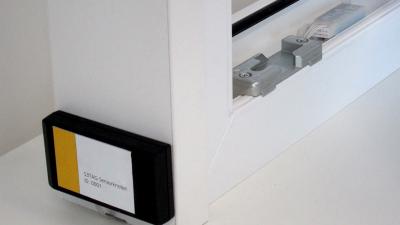
Controls & Automation
FEATURE – Installing a wireless window sentinel
September 25, 2012 - Now that we're more than halfway through September, the autumn weather feels like it's quickly approaching. If you happen to be away from home, but left a window open, either deliberately or accidentally, you may be in for a wet surprise when you come home.
September 26, 2012 By Fraunhofer-Gesellschaft

However, it does not have to be like that. Thanks to a new sensor system, such situations can now be avoided. A sensor embedded in the window frame detects if a window is closed, cracked open or wide open and sends this information to a base station at the main door. When leaving the house, a resident can tell at a glance which windows are open and which are closed. Since the system enables remote queries, users can even monitor windows with a smartphone.
Researchers at the Fraunhofer Institute for Integrated Circuits IIS, based in Erlangen and Nuremberg, Germany, have developed the product in close collaboration with Seuffer, a Calw-based company, which has been an IIS industry partner for over a decade.
 The intelligent window monitor is based on the IIS-developed HallinOne sensor – a 3D magnetic field sensor that is already being used in certain mass-produced washing machines. The sensor helps determine the exact position of the drum.
The intelligent window monitor is based on the IIS-developed HallinOne sensor – a 3D magnetic field sensor that is already being used in certain mass-produced washing machines. The sensor helps determine the exact position of the drum.
“We’ve adapted our technology for the window application. A fingernail-sized sensor embedded in the inner frame detects sash and handle positions by measuring any changes in the angle and position of a magnet that’s embedded in the bottom of the sash. When you lock the window, for example, the magnet moves to the right,” explained IIS engineer Klaus-Dieter Taschka. “The sensor even detects if a casement window appears to be properly latched, but has actually just been pulled shut. No other system can do this.”
In addition, the system is tamper-proof to help protect against break-ins– the magnet cannot be removed without the sensor detecting its removal.
Also embedded in the frame is an RF node. Comprising of a radio unit and a microcontroller, it uses the s-net technology developed by IIS for extremely energy-efficient wireless data transmission to a base station. This can take the form of a PC, cell phone or tablet, even a room controller.
“The s-net wireless sensor network is a multi-hop network where sensor nodes exchange data both with each other and with master nodes,” said Taschka.
Nodes have a communication range of 20m to 30m, which defines the maximum distance between one window and the next. Multi-hop capability means the system can cover vast areas, making it suitable for use in businesses. Installed in an office building, it could provide front-desk security staff with window status information and so do away with the need for walk-through checks.
Another feature of the window sentinel is that it requires no cables or batteries. The sensor draws all the power it needs from its surroundings. The underlying technology, known among experts as “energy harvesting”, enables power to be derived from ubiquitous sources such as air currents, vibrations or in this case sunlight and ambient heat. Thermoelectric generators embedded in the window frame transform heat into power. Solar cells attached to the outer window frame also help power the 3D sensor.
“Our tests showed that this works even in north-facing windows,” said Andreas Buchholz, head of Research and Development at Seuffer.
However, the system only suitable for everyday use if all sensors function reliably. To help ensure this, each chip is equipped with a coil that creates a magnetic field as soon as power is applied. If a signal is emitted, then the sensor is intact.
“The window monitor is the result of a vigorous exchange of ideas we’ve maintained over the years with Fraunhofer researchers,” said Buchholz.
The window, which includes the sensor, magnet, RF node and solar cell, is currently available as a prototype. By the end of the year, it is expected to be ready for mass production. Manufacturing will be done by Seuffer, which also developed the electronics and produced the housing.
***
By Fraunhofer-Gesellschaft
Photo courtesy Fraunhofer IIS
Print this page